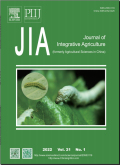农业科学学报(英文)2024,Vol.23Issue(11):3912-3922,11.DOI:10.1016/j.jia.2024.09.010
The shaping of milk-flavored white tea:More than a change in appearance
The shaping of milk-flavored white tea:More than a change in appearance
摘要
关键词
shaping/milk-flavored white tea/Camellia sinensis/tea processing/tea flavorKey words
shaping/milk-flavored white tea/Camellia sinensis/tea processing/tea flavor引用本文复制引用
Jiao Feng,Weisu Tian,Jinyuan Wang,Shuping Ye,Guanjun Pan,Bugui Yu,Fang Wang,Hongzheng Lin,Zhilong Hao..The shaping of milk-flavored white tea:More than a change in appearance[J].农业科学学报(英文),2024,23(11):3912-3922,11.基金项目
The study obtained support from the National Key Research and Development Program of China(2022YFD2101101),the Modern Agricultural(Tea)Industry Technology System of Fujian Province,China([2021]No.90),the Guiding Project of Science and Technology Department in Fujian Province,China(2022N0031),the Special Fund Program for Science and Technology Innovation of Fujian Agriculture and Forestry University,China(KFB23203),and the Special Fund for Science and Technology Innovation of Fujian Zhang Tianfu Tea Development Foundation,China(FJZTF01).We thank Prof.Xiaomin Yu and Dr.Xiaxia Wang from Haixia Institute of Science and Technology,Fujian Agriculture and Forestry University,China for technical support. (2022YFD2101101)

